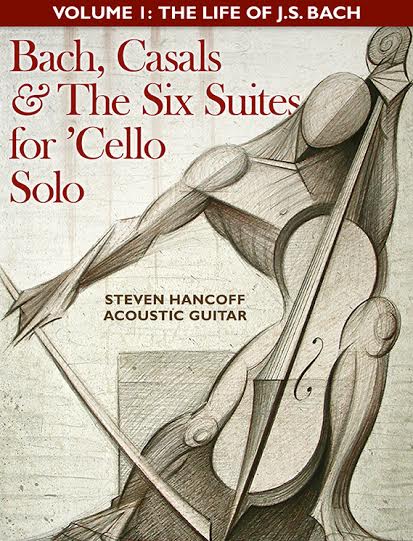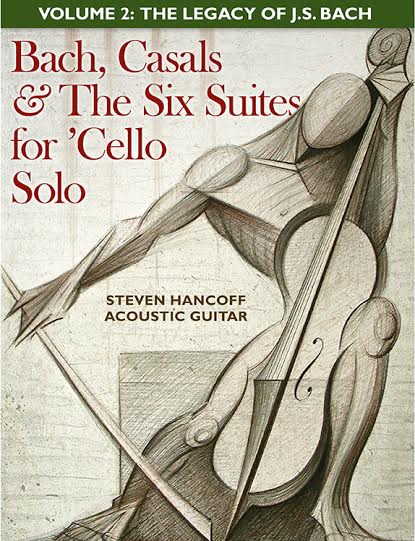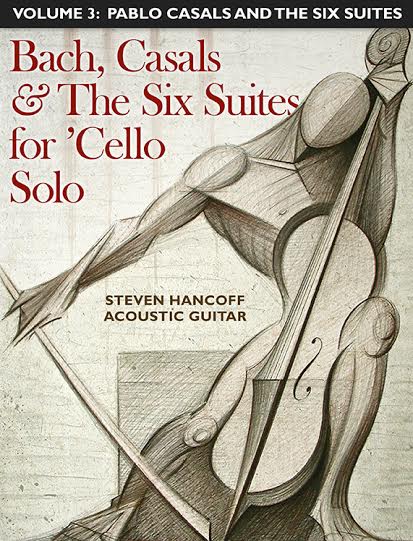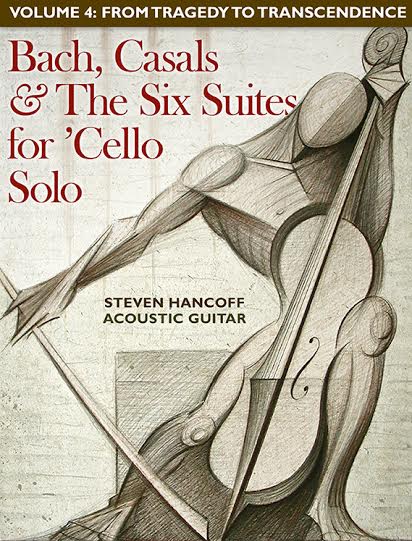ENTER THE CREATIVE WORLD OF J.S. BACH IN INTERNATIONALLY RENOWNED GUITARIST STEVEN HANCOFF’S GROUNDBREAKING FOUR-VOLUME E-BOOK
Book Details:
Book Title: Bach, Casals & The Six Suites for 'Cello Solo: Volumes 1-4 by Steven Hancoff
Category: Adult non-fiction, 1189 pages
Genre: Biography / Music
Publisher: iTunes
Release date: June 2015
Tour dates: Nov 30 - Dec 18, 2015
Content Rating: G
Book Description:
FROM TRAGEDY TO TRANSCENDENCE
A Totally Immersive Multimedia Experience
Richly Detailed Text Embedded with More Than 1,000 Illustrations Illuminating Bach’s Masterpiece, from Its Creation to Its Legacy
Bach, Casals and the Six Suites for ’Cello Solo and 3-CD set Audio Recording of ’Cello Suites to be Released June 23rd
Exclusively on iTunes and CD Baby
Includes Hancoff’s Complete Recording Of His Acoustic Guitar Transcription of Bach’s ’Cello Suites
From tragedy to transcendence is the theme that embodies the essence of the life and work of Johann Sebastian Bach. “This man, ‘the miracle of Bach,’ as Pablo Casals once put it, led a life of unfathomable creativity and giftedness on the one hand and neglect and immense tragedy on the other,” says Hancoff.
Bach’s life was rife with hardship and tragedy from the start. By the time he was nine years old, he had witnessed the deaths of three siblings and then, within a year, his father and mother also passed away.
For all his education and talent, however, his first job was serving as a lackey for a drunkard duke. Subsequently, he spent the next fifteen years in the employ of Weimar’s harshly ascetic Duke Wilhelm Ernst, who cared little for music. When he was twenty-two, he married the love of his live, his distant cousin, Maria Barbara Bach. During the thirteen years they were married, she bore him seven children, three of whom died at birth.
In 1717, Prince Leopold of Cöthen offered Bach a position as the musical director for Cöthen. Bach jumped at the chance. The officials of Weimar, however, threw him in jail for “the crime” of daring to resign his present position. Still, Bach was on the verge of a career breakthrough.
Three years into his happy and contented tenure in Cothen, Prince Leopold and Bach visited the spa town of Carlsbad for a month of vacationing and music-making. Unfortunately, upon his return Bach learned of the death of his wife and then only when he entered into his home. Imagine the shock, the impact. He never even discovered the cause of death.
Yet this tragic setback in Bach’s life was a major turning point because he came to grips with his personal tragedy by unleashing a flood of masterpieces for which he is and will be forever revered. First came the Six Violin Sonatas and Partitas for Violin Solo and then the Six Suites for ’Cello Solo.
In the ’Cello Suites we hear Bach expressing his own seeking, yearning, love, loss, sorrow, grief and determination and their overtones of surrender, resolution affirmation and transcendence. He aspired to articulate an ultimate personal confession, a revelation, entirely unique, entirely sublime, as an ultimate act of artistic and creative testimony, a heavenly statement about his own life and even of life itself—as a final gift and an enduring, heavenly send-off for his beloved wife.
Bach, Casals and the Six Suites for ’Cello Solo invites readers and music lovers into a unique experience, contained in an immersive four-volume e-book from Steven Hancoff – a virtuoso musician’s restless, passionate, multimedia exploration of a musical masterpiece that only grows in stature almost three centuries after it was written.
The many fascinating and inspiring aspects of the book include:
• How Bach struggled and overcame adversity and the lessons his example offer us today.
• The ultimate meaning of the Six Suites for ’Cello.
• How almost all of Bach’s works would have nearly sunk into oblivion were it not for the extraordinary efforts of Sara Levy, the great aunt of Felix Mendelssohn, to rescue them.
• How Felix Mendelssohn singlehandedly created with the performance of the St. Matthew Passion a Bach renaissance and a legacy that continues to be enjoyed to the present day.
• The miraculous discovery of the six ’Cello Suites by Pablo Casals in a Barcelona thrift shop and why he studied them for twelve years before performing them in public.
• What Pablo Casals meant when he spoke of “the miracle of Bach.” Bach, Casals and the Six Suites for ’Cello Solo promises to be an adventure for anyone fascinated by the enduring power of music, art and why they matter.
Book Title: Bach, Casals & The Six Suites for 'Cello Solo: Volumes 1-4 by Steven Hancoff
Category: Adult non-fiction, 1189 pages
Genre: Biography / Music
Publisher: iTunes
Release date: June 2015
Tour dates: Nov 30 - Dec 18, 2015
Content Rating: G
Book Description:
FROM TRAGEDY TO TRANSCENDENCE
A Totally Immersive Multimedia Experience
Richly Detailed Text Embedded with More Than 1,000 Illustrations Illuminating Bach’s Masterpiece, from Its Creation to Its Legacy
Bach, Casals and the Six Suites for ’Cello Solo and 3-CD set Audio Recording of ’Cello Suites to be Released June 23rd
Exclusively on iTunes and CD Baby
Includes Hancoff’s Complete Recording Of His Acoustic Guitar Transcription of Bach’s ’Cello Suites
From tragedy to transcendence is the theme that embodies the essence of the life and work of Johann Sebastian Bach. “This man, ‘the miracle of Bach,’ as Pablo Casals once put it, led a life of unfathomable creativity and giftedness on the one hand and neglect and immense tragedy on the other,” says Hancoff.
Bach’s life was rife with hardship and tragedy from the start. By the time he was nine years old, he had witnessed the deaths of three siblings and then, within a year, his father and mother also passed away.
For all his education and talent, however, his first job was serving as a lackey for a drunkard duke. Subsequently, he spent the next fifteen years in the employ of Weimar’s harshly ascetic Duke Wilhelm Ernst, who cared little for music. When he was twenty-two, he married the love of his live, his distant cousin, Maria Barbara Bach. During the thirteen years they were married, she bore him seven children, three of whom died at birth.
In 1717, Prince Leopold of Cöthen offered Bach a position as the musical director for Cöthen. Bach jumped at the chance. The officials of Weimar, however, threw him in jail for “the crime” of daring to resign his present position. Still, Bach was on the verge of a career breakthrough.
Three years into his happy and contented tenure in Cothen, Prince Leopold and Bach visited the spa town of Carlsbad for a month of vacationing and music-making. Unfortunately, upon his return Bach learned of the death of his wife and then only when he entered into his home. Imagine the shock, the impact. He never even discovered the cause of death.
Yet this tragic setback in Bach’s life was a major turning point because he came to grips with his personal tragedy by unleashing a flood of masterpieces for which he is and will be forever revered. First came the Six Violin Sonatas and Partitas for Violin Solo and then the Six Suites for ’Cello Solo.
In the ’Cello Suites we hear Bach expressing his own seeking, yearning, love, loss, sorrow, grief and determination and their overtones of surrender, resolution affirmation and transcendence. He aspired to articulate an ultimate personal confession, a revelation, entirely unique, entirely sublime, as an ultimate act of artistic and creative testimony, a heavenly statement about his own life and even of life itself—as a final gift and an enduring, heavenly send-off for his beloved wife.
Bach, Casals and the Six Suites for ’Cello Solo invites readers and music lovers into a unique experience, contained in an immersive four-volume e-book from Steven Hancoff – a virtuoso musician’s restless, passionate, multimedia exploration of a musical masterpiece that only grows in stature almost three centuries after it was written.
The many fascinating and inspiring aspects of the book include:
• How Bach struggled and overcame adversity and the lessons his example offer us today.
• The ultimate meaning of the Six Suites for ’Cello.
• How almost all of Bach’s works would have nearly sunk into oblivion were it not for the extraordinary efforts of Sara Levy, the great aunt of Felix Mendelssohn, to rescue them.
• How Felix Mendelssohn singlehandedly created with the performance of the St. Matthew Passion a Bach renaissance and a legacy that continues to be enjoyed to the present day.
• The miraculous discovery of the six ’Cello Suites by Pablo Casals in a Barcelona thrift shop and why he studied them for twelve years before performing them in public.
• What Pablo Casals meant when he spoke of “the miracle of Bach.” Bach, Casals and the Six Suites for ’Cello Solo promises to be an adventure for anyone fascinated by the enduring power of music, art and why they matter.
Buy the music & ebooks: iTunes
Excerpt – Volume One: The Monumental Works
Mass in B Minor: The Numerology
In the esoteric world of Bach scholarship, much is made of the significance of numerological symbolism, which in Mass in B Minor jumps out at a person seeking such significance.
The first two movements of the Credo portion each begin with the words Credo in Unum Deum (“I Believe in One God.”)
14 = Bach
Numerologically the name Bach equals the number 14 because, when the letters of his name are matched to their position in the alphabet:
B = 2
A = 1
C = 3
H = 8
So, 2 + 1 + 3 + 8 = 14 = [Johann Sebastian] Bach
Each of these movements of the Credo has 14 entrances of the musical subject. “I Believe in One God” is proclaimed 14 times, and is thus said to signify: “I, Bach, Believe in One God.”
This cannot be a numerological coincidence because the section Crucifixus also contains 14 entrances of the musical subject.
27 = God
The Holy Trinity = 3 x 3 x 3 = 27 = God
The Mass in B Minor is composed in 27 movements.
The final movement, Dona Nobis Pacem (“Give Us Peace”), has 27 entrances of the musical subject.
43 = CREDO (“I BELIEVE”)
C = 3
R = 17
E = 5
D = 4
O = 14
3 + 17 + 5 + 4 + 14 = 43
The chorus actually exclaims “CREDO!” 43 times.
From here it gets even more complex:
129 = “I Believe in God”
In the Credo portion, the first movement begins Credo in Unum Deum. There are 45 measures in this movement.
Then, the second movement, Patrem Omnipotentem [“Omnipotent Father”], also begins with the words Credo in Unum Deum. There are 84 measures in this movement.
45 measures + 84 measures = 129
43 [I Believe] x 3 [In God] = 129
Meet the author:
Steve Hancoff began playing guitar when he was 13 years old, captivated by the folk music craze of the 1960s. Within a year he was performing in coffeehouses around Baltimore and Washington, D.C.
For nearly 15 years, he toured the world—about 50 countries—as an official Artistic Ambassador representing the United States of America. His recordings include Steel String Guitar, New Orleans Guitar Solos, Duke Ellington for Solo Guitar, and The Single Petal of A Rose. He is also the author of Acoustic Masters: Duke Ellington for Fingerstyle Guitar and New Orleans Jazz for Fingerstyle Guitar. He is a graduate of St. John’s College, home of the “100 Great Books of the Western World” program and has a Masters degree in clinical social work. He is a psychotherapist, a Rolfer, and a practitioner of Tai Chi. An avid hiker, he is also a member of the Grand Canyon River Guides Associations.
Connect with the author: Website ~ Twitter ~ Facebook








Hancoff's fervor for the Bach suites echoes Casals’ devotion… strains of music dovetail with what is the largest collection of Bach-inspired visual art ever amassed… It is an antique subject elegantly rendered in an impossibly light 21st-century container. – Roxane Assaf, Huffington Post, writing about the iBook
ReplyDeleteDear Joana,
Thank you.
Eight years! Eight years ago, I started the process of transcribing Bach’s masterpiece Six Suites for Cello Solo for my acoustic guitar. My only intention was to transcribe and then record them. But the more I worked, the more I felt a need to learn about the man, and especially the circumstances of his life, when he composed the Cello Suites. And the more I discovered, the more questions and ideas arose …until I began to realize that this was not simply a music project, but this was transforming itself into a life’s work. Fulfilling that mission became my purpose.
And now, the project is done and released. And I want to tell you how much I appreciate your helping to make this work known to the world.
I have come to feel that the saga I have discovered and articulated in the iBooks is the pre-eminent and most grand and by far the most profoundly serendipitous legend of Western culture. I intend to be touring the country with a multimedia presentation of it, telling the story with slideshow and video – pictures galore -- over the next years. The presentation will be entertaining and enlightening.
Thanks again…
Steven Hancoff